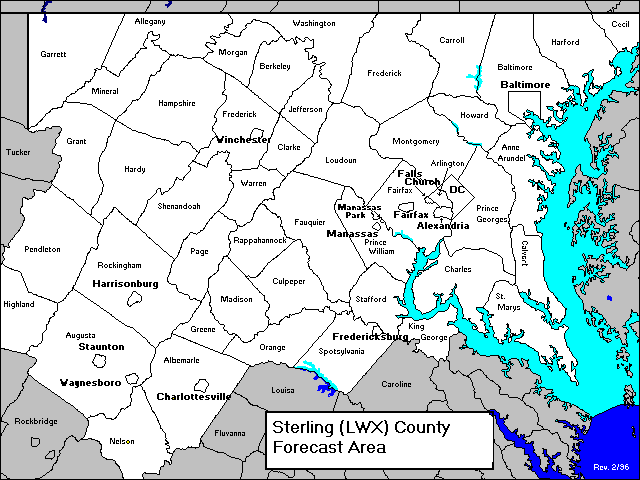What is Skywarn?
Skywarn is a network of volunteer severe weather spotters, who act as the "eyes and ears" of National Weather Service (NWS) offices throughout the county. The spotters are trained by local NWS Forecast Offices on how to spot and report severe thunderstorms, tornadoes, hail and flooding. In some areas, spotters also report snowfall and ice accumulation.
The National Capital Area Skywarn Support Group
NWS Baltimore / Washington Forecast Office in Sterling, Virginia, has been recruiting and training spotters into its expanded network since 1990. there are currently over 5,000 volunteers who cover 44 counties, plus Baltimore City and the District of Columbia.
The network comprises an area from the west of the Susquehanna River and Chesapeake Bay to the Allegheny Mountains; and from the Mason-Dixon line down to St. Mary's, King George, Spotsylvania, Orange, Nelson,and Highland Counties.
Who Are Our Spotters?
Skywarn volunteers are a diverse group, ranging from weather enthusiasts or public-service oriented people such as amateur radio operators, REACT members, or emergency response personnel. Spotters are all ages, from 14 through retirement age, with many professions represented. Skywarn volunteers have a common interest in weather and a strong desire to help the community.
How Does Skywarn Work?
When hazardous weather occurs, Skywarn volunteers report what is happening at their location. They are asked to report conditions such as rain and snow amounts, hail, flooding, tornadoes, or damage to trees or property.
Reports arrive at the NWS office via telephone, email, social media, and the Skywarn amateur radio net. The reports are combined with radar, lightning, satellite and computer model long-copy-n to determine what the storms will do next. Spotters provide the "ground truth" to NWS forecasters: important information that radar won't always show. The reports are used by forecasters to issue public statements, watches, warnings, advisories, and short-term forecasts. These products reach the public through the Internet, NOAA weather radio, the media and other means.
Skywarn reports also go into Storm Data, which is an official publication that documents severe weather across the country. Storm Data can be used to create a severe weather climatologic (or history) of the local county and city.
How Does the Skywarn Amateur Radio Net Work?
Many Skywarn volunteers are also licensed amateur radio operators. The ability of many amateur radio operators to operate during power outages is an asset to the NWS. During severe weather, amateur radio volunteers staff the radio station at the NWS office, using the call sign WX4LWX. They talk to spotters in the area where a storm is hitting, and request information needed by forecasters, such as hail size or rainfall accumulation. AS many of you saw on June 29th, 2012, large storms such as hurricanes and derechos can knock out phone service. Skywarn amateur radio volunteers help when there are communications outages so that NWS can continue to receive weather reports and feed warnings and other critical information out to communities. The WX4LWX station can also communicate with the National Hurricane Center, if needed.
Who is Eligible to Become a Skywarn Spotter?
Those wishing to become part of Skywarn must be:
* age 14 or older
* able to observe the weather (though no instruments are required)
* able to access a telephone or amateur radio network to report on life-threatening or other conditions. Some also use email to report less urgent conditions.
How Do I become a Skywarn Volunteer Spotter?
Skywarn spotters are required to take the Skywarn Basics I class taught by NWS meteorologists. This 2-hour seminar will teach you the basics of how Skywarn operates, what weather threats affect the region and how to spot them, what information to report, and when to report it. A few weeks after the class, you will receive a special Skywarn ID card with reporting instructions.. There is no cost for the class. Classes are hosted around the area by amateur radio clubs, counties, and their organizations, Optional threat classes, such as Tropical/Hurricane, Winter Weather, and Flooding are offered during certain times of the year. Registration is required for all the classes. This is done by contacting the person listed for a given class.
How do I register for a Spotter Class?
Those interested are requested to pre-register for classes, to ensure availability of seating and handouts for all attendees. Classes are listed on the
NWS web site
How Do I Get my Amateur Radio License?
The FCC requires that all amateur radio operators pass a 35-question multiple-choice exam. The exam is offered around the area and administered by volunteer examiners. Radio clubs, books, software, and online test sites will help you prepare for the exam. Find information on amateur radio at the
American Radio Relay League's web site




